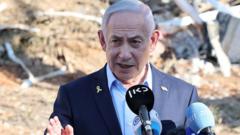As negotiations unfold, both sides appear to have entrenched positions on key issues. Netanyahu has instructed his team to pursue a ceasefire under terms acceptable to Israel. While Hamas claims to have engaged with the latest ceasefire proposal positively, significant disagreements remain, particularly regarding the cessation of hostilities and the withdrawal of Israeli troops—conditions that the Israeli government has previously rejected.
Netanyahu reaffirmed his commitment to three primary objectives: securing the release of all hostages, dismantling Hamas's military capacity, and ensuring that Gaza no longer poses a threat to Israel. The indirect ceasefire talks—mediated by Qatari and Egyptian officials—need to navigate these contentious points that have hindered previous discussions since the last ceasefire ended in March.
Amid renewed military operations against Hamas and an extensive blockade on Gaza, the conflict's toll on civilian life continues. The Israeli military reported recent attacks targeting Hamas, spurring further loss of life in Gaza—a situation that raises international concern and pressure for a diplomatic resolution.
As Israeli citizens demand action to secure the release of hostages, there is a notable division within Netanyahu's cabinet, where hardliners oppose any ceasefire that does not result in the total defeat of Hamas. The success of the ongoing negotiations and Netanyahu's consultations with Trump could determine the likelihood of achieving a mutually acceptable compromise or if this will lead to further escalation.
With the rising casualty figures since hostilities resumed—including over 57,000 deaths in Gaza since the onset of renewed conflict—families of hostages and residents in Gaza are left hoping for meaningful progress in the talks. The pressing question remains whether these discussions in Qatar can yield substantial outcomes or whether they will ultimately fall short of resolving the ongoing crisis.
Netanyahu reaffirmed his commitment to three primary objectives: securing the release of all hostages, dismantling Hamas's military capacity, and ensuring that Gaza no longer poses a threat to Israel. The indirect ceasefire talks—mediated by Qatari and Egyptian officials—need to navigate these contentious points that have hindered previous discussions since the last ceasefire ended in March.
Amid renewed military operations against Hamas and an extensive blockade on Gaza, the conflict's toll on civilian life continues. The Israeli military reported recent attacks targeting Hamas, spurring further loss of life in Gaza—a situation that raises international concern and pressure for a diplomatic resolution.
As Israeli citizens demand action to secure the release of hostages, there is a notable division within Netanyahu's cabinet, where hardliners oppose any ceasefire that does not result in the total defeat of Hamas. The success of the ongoing negotiations and Netanyahu's consultations with Trump could determine the likelihood of achieving a mutually acceptable compromise or if this will lead to further escalation.
With the rising casualty figures since hostilities resumed—including over 57,000 deaths in Gaza since the onset of renewed conflict—families of hostages and residents in Gaza are left hoping for meaningful progress in the talks. The pressing question remains whether these discussions in Qatar can yield substantial outcomes or whether they will ultimately fall short of resolving the ongoing crisis.





















